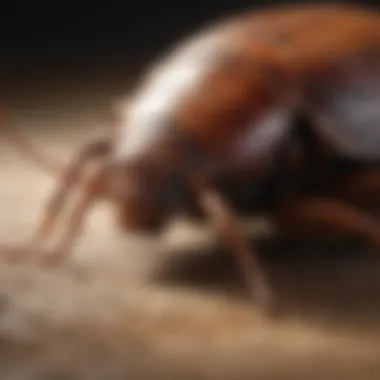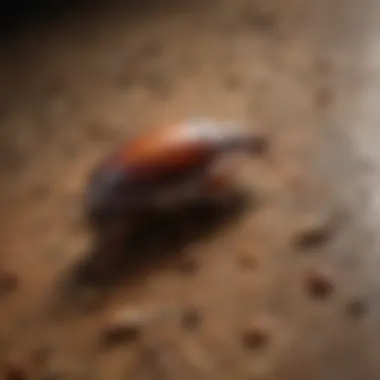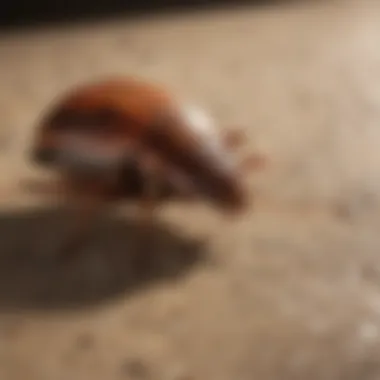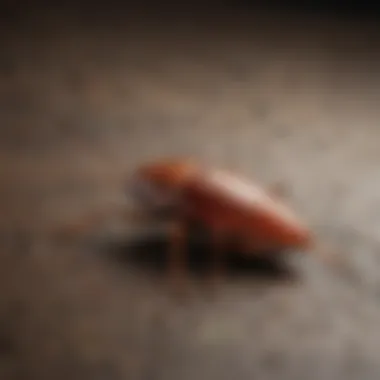Identifying Signs of Cockroach Infestation: How to Spot a Potential Cockroach Problem


Preventive Pest Control Strategies
When it comes to safeguarding your home against pesky intruders like cockroaches, implementing preventive pest control strategies is crucial. One of the key aspects to consider is enhancing your house's exterior protection. Begin by meticulously sealing any cracks or openings that can serve as entry points for unwanted guests. Clearing debris in your yard is also essential to eliminate hiding spots for pests and prevent them from entering your living space. Additionally, investing in quality screens for windows and doors can further fortify your home's defense against cockroach infestations.
In terms of yard maintenance, sticking to essential routines is paramount. Regularly mowing the lawn, trimming bushes, and removing standing water can significantly reduce the attractiveness of your yard to pests. Implementing methods like using pest-repelling plants and natural remedies can further contribute to keeping your yard pest-free.
Maintaining indoor cleanliness is another key factor in deterring cockroaches from invading your space. Adopt expert cleaning tips and techniques to ensure that your home remains unattractive to these unwanted critters. Minimizing clutter, fixing leaks promptly, and storing food properly are simple yet effective ways to create a pest-resistant indoor environment.
Efficient waste disposal is equally vital in pest prevention. Make sure to dispose of garbage properly in sealed containers and regularly take out the trash. A correctly managed waste disposal system not only prevents cockroach infestations but also contributes to overall cleanliness and hygiene in your living area.
Furthermore, exploring innovative pest prevention strategies can provide an additional layer of protection for your home. From using ultrasonic repellent devices to installing motion-activated lighting, there are various modern approaches to fortifying your home against unwanted pests.
Identifying Pest Risk Areas
To effectively combat cockroach infestations, it is essential to identify potential pest risk areas within your home. Conduct a thorough inspection of moisture-prone areas such as basements, attics, and bathrooms to pinpoint damp conditions that can attract cockroaches. Implementing moisture control measures like repairing leaks and improving ventilation can help prevent infestations in these areas.
An essential part of pest control is inspecting crack and crevices in your home. These tiny openings often serve as entry points for pests like cockroaches. Seal off cracks with appropriate materials and regularly inspect vulnerable areas to maintain a barrier against unwelcome intruders.
When it comes to outdoor spaces, greenery inspection is crucial for identifying potential pest risks. Overgrown vegetation can create ideal habitats for insects and rodents. By maintaining your yard, removing debris, and trimming foliage, you can greatly reduce the likelihood of a pest infestation.
Aside from the typical pest risk areas, it is also important to consider other potential entry points for pests. Attics, crawl spaces, and storage areas are commonly overlooked but can harbor pests if not properly maintained. Taking proactive measures such as decluttering these spaces and sealing off any openings can significantly minimize the risk of infestations.
Effective Pest Control Methods
Mastering effective pest control methods is essential for combatting cockroach infestations and maintaining a pest-free environment. Natural repellents provide a safe and eco-friendly solution for controlling pests. Essentials oils like peppermint and lavender, along with plants such as basil and rosemary, can act as natural deterrents against cockroaches.


In cases where natural remedies may not suffice, chemical sprays can be utilized with caution. It is important to follow instructions carefully and opt for professional-grade products to ensure effective pest eradication. Implementing chemical sprays in targeted areas can yield efficient results in combating cockroach populations.
Pest traps offer another effective pest control solution. By strategically placing traps in areas frequented by cockroaches, you can capture and remove these pests safely and efficiently. Regular monitoring and disposal of trapped pests are essential to prevent further infestations.
Biological control methods involve leveraging natural predators to manage pest populations. Introducing beneficial organisms like ladybugs or nematodes can aid in controlling pests like aphids and caterpillars in your environment. These environmentally-friendly techniques offer a sustainable approach to pest management.
Embracing innovative pest control methods beyond traditional options can provide additional layers of defense against cockroach infestations. From electronic pest repellents to ultrasonic devices, exploring diverse pest control solutions allows for a more comprehensive approach to managing pest populations.
To ensure effective pest control, it is essential to identify common pest species that may invade your home. Recognizing insects like ants, cockroaches, and spiders enables targeted control measures to be employed. Similarly, identifying rodents such as mice and rats allows for specific prevention strategies to be implemented.
Bird species can also impact home environments, with some species causing disturbances or health hazards. Addressing bird-related issues proactively can help mitigate risks and ensure a pest-free living space. By understanding the behaviors of troublesome bird species, you can take necessary steps to deter them from your property.
Dealing with wildlife encounters, such as raccoons or squirrels, requires a tailored approach to ensure both human safety and animal welfare. Implementing humane wildlife control measures and adopting preventative actions can help manage wildlife presence in your surroundings effectively.
In addition to common pest species, there are lesser-known pests that can pose risks to your home. Being able to identify and manage these pests effectively can prevent potential infestations and protect your living environment.
DIY Pest Control Techniques
For individuals seeking a hands-on approach to pest control, employing do-it-yourself techniques can be both cost-effective and empowering. Homemade pest control solutions offer eco-friendly alternatives to traditional pest management methods. Utilizing common household items like vinegar, baking soda, and essential oils can help repel pests naturally.
Essential oils are particularly effective in repelling pests like cockroaches due to their strong aromatic properties. By incorporating oils like tea tree or eucalyptus into your cleaning routine, you can create a bug-free environment while enjoying the benefits of natural fragrances.
Setting up effective pest traps and barriers is another DIY approach to controlling pest populations. From simple glue traps to more sophisticated barriers, employing these methods strategically can aid in capturing and preventing pest infestations.
When seeking pest control products, opting for reputable brands ensures quality and efficacy. Trusted brands in the pest control industry offer a range of products designed to target specific pests and provide lasting results. Safeguarding your home with reliable solutions from reputable brands can offer peace of mind in managing pest issues effectively.
Incorporating miscellaneous DIY pest control techniques provides further options for addressing diverse pest problems at home. Whether it's utilizing natural repellents, setting up physical barriers, or exploring innovative solutions, DIY methods empower homeowners to actively protect their living spaces from unwanted pests.


Visual Indicators
Visual indicators play a crucial role in identifying potential cockroach infestations within your living or working spaces. Understanding these visual clues can be the first step towards effectively addressing the issue and implementing necessary preventive measures. By paying attention to specific visual markers, you can proactively combat these unwanted pests, ensuring a cleaner and healthier environment for yourself and your family. Visual Indicators serve as the frontline of defense against cockroach infestations, allowing you to take prompt action and safeguard your premises.
Sightings of Cockroaches
As one of the most evident signs of a cockroach infestation, sightings of these pests in your living areas should raise immediate concern. The visible presence of cockroaches in commonly used spaces indicates a potentially significant infestation that requires immediate attention. Visible presence of cockroaches in living areas serves as a direct indicator of the extent of the problem, prompting you to take decisive action to eradicate these pests swiftly. Recognizing this key characteristic is vital in assessing the severity of the infestation and devising an appropriate eradication strategy.
On the other hand, finding dead cockroaches in hidden spaces signals an ongoing infestation in less frequented areas of your home. While the absence of live insects may seem reassuring, discovering dead cockroaches in hidden nooks and crannies highlights the persistent nature of the infestation. Understanding this unique feature is crucial in addressing areas that may serve as breeding grounds for these pests, ensuring a comprehensive approach to eliminating the infestation.
Egg Casings and Droppings
Discovering small, oval-shaped egg casings is a telltale sign of an active cockroach population within your premises. The presence of these casings indicates the potential for rapid reproduction and population growth, underscoring the urgency of addressing the infestation promptly. Recognizing this key characteristic helps in identifying areas where cockroach eggs may be concealed, allowing for targeted interventions to disrupt their lifecycle effectively.
Moreover, spotting pepper-like droppings in corners serves as an additional visual indicator of cockroach activity. The presence of these droppings signifies the presence of cockroach colonies and their feeding sites, shedding light on areas that require thorough cleaning and treatment. Understanding this unique feature enables you to pinpoint high-traffic zones for these pests, facilitating focused efforts to eliminate both the insects and their food sources.
Odor and Sounds
In the vast realm of identifying cockroach infestations, the section devoted to Odor and Sounds plays a crucial role. By honing in on the specific olfactory and auditory cues indicative of roach presence, individuals can proactively address any potential issues within their living or working spaces, thereby circumventing the escalation of infestations that could lead to broader concerns. This detailed exploration enhances the comprehensive nature of this article, shedding light on often overlooked yet telling signs that warrant immediate attention.
Unpleasant Smell
A musty, oily odor in confined spaces represents a red flag in the realm of cockroach infestation detection. This particular scent serves as a distinctive marker of potential trouble, alerting individuals to the presence of these unwanted pests. Its unique characteristic lies in its ability to permeate enclosed areas, making it harder to pinpoint the exact location of the infestation. Despite its discomforting nature, this odor acts as a beneficial indicator within the context of this article, offering a clear signal for individuals to investigate further.
Rustling or Hissing Sounds
When it comes to rustling or hissing sounds within dark areas at night, the specific auditory aspect becomes a valuable asset in the identification process of cockroach infestations. These faint noises underscore the nocturnal activities of roaches, providing a sonic footprint of their presence that might otherwise go unnoticed during daylight hours. The key characteristic of these sounds lies in their subtlety, requiring heightened awareness and attentiveness from individuals to discern them amidst the backdrop of nighttime silence. While these noises may unsettle some, they serve as invaluable clues within the framework of this article, aiding in the prompt detection and subsequent mitigation of potential infestation issues.


Damage and Traces
In the realm of identifying cockroach infestations, understanding the ramifications of damage and traces is paramount. These visible signs not only point towards the presence of these unwanted guests but also serve as crucial indicators for homeowners and business owners to take swift action. Delving into the nuances of damage and traces illuminates the severity of the situation, prompting urgency in addressing the issue effectively. By focusing on specific elements such as gnaw marks, grease stains, holes, and discarded shells, individuals can gain valuable insights into the extent of the infestation and tailor their remediation efforts accordingly.
Gnaw Marks and Grease Stains
When inspecting for cockroach infestation, the presence of gnaw marks on food packaging and grease stains along baseboards can offer telling clues. These indicators not only signify the foraging behavior of cockroaches but also underline the potential risks associated with their presence. Delving into the specifics of finding chew marks on food packaging unveils the destructive tendencies of these pests, emphasizing the need for swift intervention to prevent further contamination and damage to consumables. Likewise, greasy marks along baseboards serve as visible evidence of cockroach movement, pinpointing areas of activity and highlighting the need for thorough cleaning and disinfection.
Holes and Shells
Moreover, the presence of small holes in cardboard and discarded cockroach shells adds another layer of insight into the infestation's severity. Small holes in cardboard not only indicate access points for cockroaches but also underscore the potential risks of food contamination and property damage. By understanding the unique features of these holes and their implications, individuals can develop targeted pest control strategies to mitigate the infestation's impact. Similarly, discarded cockroach shells serve as tangible evidence of cockroach molting, shedding light on the breeding cycle and population density within the premises. Recognizing the significance of these shells enables homeowners and business owners to gauge the infestation's scale and take proactive measures to eradicate these resilient pests effectively.
Behavioral Patterns
Nocturnal Activities
Cockroaches active at night
An essential behavioral trait contributing to identifying cockroach infestations is their nocturnal nature—Cockroaches are primarily active during the night, seeking food, water, and nesting places under the blanket of darkness. This nocturnal activity is a key indicator of a potential infestation, as these pests operate when the environment is tranquil and less populated, increasing their chances of survival.
Cockroaches active at night is a strategic adaptation that allows them to avoid human detection by utilizing the cover of darkness to scavenge for food and reproduce. This particular behavior heightens the difficulty in spotting and eradicating cockroaches during daytime hours, making nighttime inspections crucial in pest management efforts.
Comprehending the habitual tendency of cockroaches to be more active at night empowers individuals to implement targeted extermination practices tailored to disrupt their routine and eliminate their presence effectively. Despite the challenges posed by nocturnal activities, being aware of this characteristic arms homeowners and business owners with the knowledge needed to confront and combat cockroach infestations proactively.
Preference for Darkness
Roaches hiding in dark, secluded spots
An integral aspect influencing the detection of cockroaches is their preference for hiding in dark, secluded spots within your premises. This behavior is driven by their instinct to seek shelter in areas that offer protection from external threats and provide easy access to food sources.
Roaches hiding in dark, secluded spots demonstrate a survival strategy that aligns with their nocturnal activities, allowing them to thrive in discreet locations away from human intervention. This behavior poses a challenge in spotting cockroaches, necessitating thorough inspections of dimly lit areas and crevices where these pests commonly dwell.
The unique feature of roaches hiding in dark, secluded spots lies in their ability to leverage undisturbed environments to breed and multiply undetected, posing a persistent threat to the hygiene and safety of your living or working space. While this behavior presents challenges in pest control efforts, understanding their inclination towards darkness equips individuals with valuable insights to target and eliminate cockroach populations effectively.



